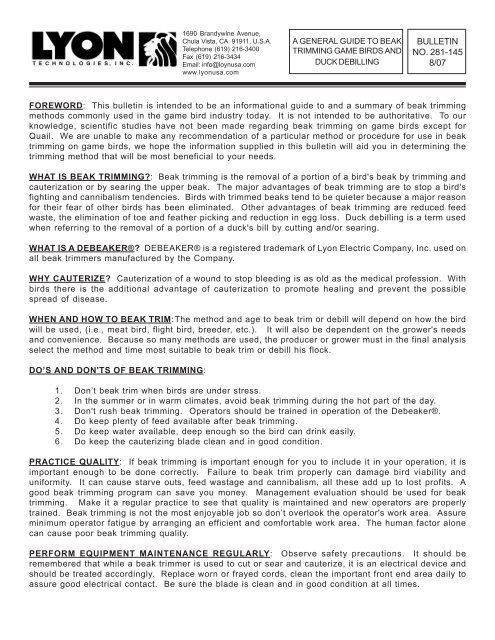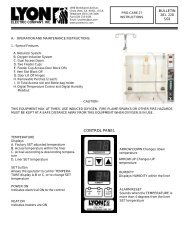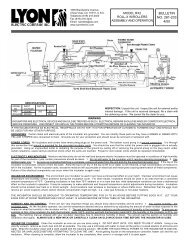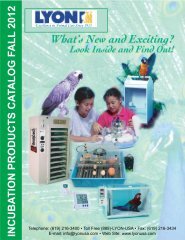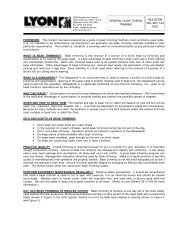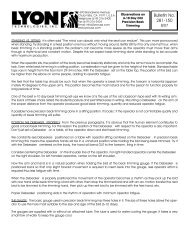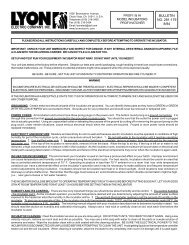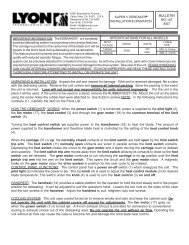a general guide to beak trimming game birds and duck debilling - Lyon
a general guide to beak trimming game birds and duck debilling - Lyon
a general guide to beak trimming game birds and duck debilling - Lyon
You also want an ePaper? Increase the reach of your titles
YUMPU automatically turns print PDFs into web optimized ePapers that Google loves.
1690 Br<strong>and</strong>ywine Avenue,<br />
Chula Vista, CA 91911, U.S.A.<br />
Telephone (619) 216-3400<br />
Fax (619) 216-3434<br />
Email: info@loynusa.com<br />
www.lyonusa.com<br />
A GENERAL GUIDE TO BEAK<br />
TRIMMING GAME BIRDS AND<br />
DUCK DEBILLING<br />
BULLETIN<br />
NO. 281-145<br />
8/07<br />
FOREWORD: This bulletin is intended <strong>to</strong> be an informational <strong>guide</strong> <strong>to</strong> <strong>and</strong> a summary of <strong>beak</strong> <strong>trimming</strong><br />
methods commonly used in the <strong>game</strong> bird industry <strong>to</strong>day. It is not intended <strong>to</strong> be authoritative. To our<br />
knowledge, scientific studies have not been made regarding <strong>beak</strong> <strong>trimming</strong> on <strong>game</strong> <strong>birds</strong> except for<br />
Quail. We are unable <strong>to</strong> make any recommendation of a particular method or procedure for use in <strong>beak</strong><br />
<strong>trimming</strong> on <strong>game</strong> <strong>birds</strong>, we hope the information supplied in this bulletin will aid you in determining the<br />
<strong>trimming</strong> method that will be most beneficial <strong>to</strong> your needs.<br />
WHAT IS BEAK TRIMMING?: Beak <strong>trimming</strong> is the removal of a portion of a bird's <strong>beak</strong> by <strong>trimming</strong> <strong>and</strong><br />
cauterization or by searing the upper <strong>beak</strong>. The major advantages of <strong>beak</strong> <strong>trimming</strong> are <strong>to</strong> s<strong>to</strong>p a bird's<br />
fighting <strong>and</strong> cannibalism tendencies. Birds with trimmed <strong>beak</strong>s tend <strong>to</strong> be quieter because a major reason<br />
for their fear of other <strong>birds</strong> has been eliminated. Other advantages of <strong>beak</strong> <strong>trimming</strong> are reduced feed<br />
waste, the elimination of <strong>to</strong>e <strong>and</strong> feather picking <strong>and</strong> reduction in egg loss. Duck <strong>debilling</strong> is a term used<br />
when referring <strong>to</strong> the removal of a portion of a <strong>duck</strong>'s bill by cutting <strong>and</strong>/or searing.<br />
WHAT IS A DEBEAKER®? DEBEAKER® is a registered trademark of <strong>Lyon</strong> Electric Company, Inc. used on<br />
all <strong>beak</strong> trimmers manufactured by the Company.<br />
WHY CAUTERIZE? Cauterization of a wound <strong>to</strong> s<strong>to</strong>p bleeding is as old as the medical profession. With<br />
<strong>birds</strong> there is the additional advantage of cauterization <strong>to</strong> promote healing <strong>and</strong> prevent the possible<br />
spread of disease.<br />
WHEN AND HOW TO BEAK TRIM:The method <strong>and</strong> age <strong>to</strong> <strong>beak</strong> trim or debill will depend on how the bird<br />
will be used, (i.e., meat bird, flight bird, breeder, etc.). It will also be dependent on the grower's needs<br />
<strong>and</strong> convenience. Because so many methods are used, the producer or grower must in the final analysis<br />
select the method <strong>and</strong> time most suitable <strong>to</strong> <strong>beak</strong> trim or debill his flock.<br />
DO’S AND DON'TS OF BEAK TRIMMING:<br />
1. Don’t <strong>beak</strong> trim when <strong>birds</strong> are under stress.<br />
2. In the summer or in warm climates, avoid <strong>beak</strong> <strong>trimming</strong> during the hot part of the day.<br />
3. Don't rush <strong>beak</strong> <strong>trimming</strong>. Opera<strong>to</strong>rs should be trained in operation of the De<strong>beak</strong>er®.<br />
4. Do keep plenty of feed available after <strong>beak</strong> <strong>trimming</strong>.<br />
5. Do keep water available, deep enough so the bird can drink easily.<br />
6. Do keep the cauterizing blade clean <strong>and</strong> in good condition.<br />
PRACTICE QUALITY: If <strong>beak</strong> <strong>trimming</strong> is important enough for you <strong>to</strong> include it in your operation, it is<br />
important enough <strong>to</strong> be done correctly. Failure <strong>to</strong> <strong>beak</strong> trim properly can damage bird viability <strong>and</strong><br />
uniformity. It can cause starve outs, feed wastage <strong>and</strong> cannibalism, all these add up <strong>to</strong> lost profits. A<br />
good <strong>beak</strong> <strong>trimming</strong> program can save you money. Management evaluation should be used for <strong>beak</strong><br />
<strong>trimming</strong>. Make it a regular practice <strong>to</strong> see that quality is maintained <strong>and</strong> new opera<strong>to</strong>rs are properly<br />
trained. Beak <strong>trimming</strong> is not the most enjoyable job so don’t overlook the opera<strong>to</strong>r's work area. Assure<br />
minimum opera<strong>to</strong>r fatigue by arranging an efficient <strong>and</strong> comfortable work area. The human fac<strong>to</strong>r alone<br />
can cause poor <strong>beak</strong> <strong>trimming</strong> quality.<br />
PERFORM EQUIPMENT MAINTENANCE REGULARLY: Observe safety precautions. It should be<br />
remembered that while a <strong>beak</strong> trimmer is used <strong>to</strong> cut or sear <strong>and</strong> cauterize, it is an electrical device <strong>and</strong><br />
should be treated accordingly. Replace worn or frayed cords, clean the important front end area daily <strong>to</strong><br />
assure good electrical contact. Be sure the blade is clean <strong>and</strong> in good condition at all times.
Bulletin 281-145 Page Two<br />
EFFECTS OF EXCESSIVE HEAT IN BEAK TRIMMING: The costliest error in <strong>beak</strong> <strong>trimming</strong> is the use of excessive<br />
or prolonged heat, especially when doing severe <strong>beak</strong> <strong>trimming</strong>. The heated blade is primarily used <strong>to</strong> cut<br />
the <strong>beak</strong> <strong>and</strong> sear the surface <strong>to</strong> s<strong>to</strong>p bleeding. The application of <strong>to</strong>o much heat may result in a ball like<br />
growth on the <strong>beak</strong> that is tender. This can be painful <strong>to</strong> the bird when eating <strong>and</strong> drinking <strong>and</strong> cause the<br />
bird's death. Never use more heat than necessary <strong>to</strong> do the job.<br />
ABOUT BLEEDERS: BLEEDING AFTER BEAK TRIMMING DOES NOT NECESSARILY MEAN BLADE<br />
TEMPERATURE WAS TOO LOW. Some <strong>birds</strong> naturally bleed as the result of trauma, however, some<br />
bleeding is better than unnecessary <strong>and</strong> excessive burning. There are other fac<strong>to</strong>rs that can cause bleeding.<br />
If the bird is under stress prior <strong>to</strong> <strong>beak</strong> <strong>trimming</strong> its blood pressure will be higher. Some avian medication will<br />
thin the blood <strong>and</strong> contribute <strong>to</strong> bleeding. It is a good idea <strong>to</strong> check with your veterinarian regarding this <strong>and</strong><br />
seek his advice relative <strong>to</strong> removal of medication for a period prior <strong>to</strong> <strong>beak</strong> <strong>trimming</strong>. Also, consider giving<br />
the <strong>birds</strong> vitamin K for a couple of days prior <strong>to</strong> <strong>beak</strong> <strong>trimming</strong> <strong>to</strong> reduce bleeding potential. Water intake<br />
could possibly raise blood pressure thus contributing <strong>to</strong> bleeding, do not allow the <strong>birds</strong> <strong>to</strong> drink water 1-2<br />
hours prior <strong>to</strong> <strong>beak</strong> <strong>trimming</strong>. Consultation with a good veterinarian is advised <strong>and</strong> the period of water restriction<br />
might vary for different species of <strong>birds</strong>.<br />
BEAK TRIMMING DAY-OLD QUAIL<br />
BEAK TRIMMING DAY-OLD QUAIL: This method of <strong>beak</strong> <strong>trimming</strong><br />
was developed by H.R. Wilson, M.G. Miller <strong>and</strong> C.R. Douglas at the<br />
Poultry Science Department, University of Florida whose permission<br />
<strong>to</strong> print this method is gratefully acknowledged. This method involves<br />
the use of a plain, slightly red hot flat blade on the De<strong>beak</strong>er® (K or<br />
KH Blade). The chick's head is held so that the <strong>to</strong>ngue will be pulled<br />
back in<strong>to</strong> the mouth. (Using the forefinger <strong>to</strong> apply a SLIGHT pressure<br />
<strong>to</strong> the throat helps, but not enough <strong>to</strong> cause the lower <strong>beak</strong> <strong>to</strong> be<br />
withdrawn.) The head is held level <strong>and</strong> the <strong>beak</strong> pointed squarely<br />
<strong>and</strong> directly at the blade. The <strong>beak</strong> is quickly <strong>to</strong>uched <strong>to</strong> the hot<br />
blade <strong>and</strong> burned so that most or all of the lighter colored tip of the<br />
upper <strong>beak</strong> is burned. Both <strong>beak</strong>s are seared approximately 1/4 of<br />
the <strong>beak</strong> length. If the egg <strong>to</strong>oth is present prior <strong>to</strong> <strong>trimming</strong>, only<br />
about .5mm of it will remain after this operation. This will result in a<br />
smaller amount of the lower <strong>beak</strong> being trimmed, with both <strong>beak</strong>s<br />
ending at the same length. If the <strong>beak</strong> is held <strong>to</strong> the blade <strong>to</strong>o long,<br />
blisters may occur; or the chick may in some cases breathe the hot<br />
super heated air around the blade causing respira<strong>to</strong>ry damage.<br />
Remember that a Quail chick has the capability of moving the upper<br />
<strong>beak</strong> <strong>to</strong> some extent <strong>and</strong> will pull it down resulting in a disproportionate<br />
burning of the lower <strong>beak</strong>. This method works well <strong>and</strong> results in a<br />
permanently shortened <strong>beak</strong> (this shortening will not be obvious <strong>to</strong><br />
the untrained eye). Observation throughout the bird's growth will<br />
illustrate how de<strong>beak</strong>ed <strong>birds</strong> look at all stages of growth.<br />
QUAIL UPPER BEAK REMOVAL<br />
QUAIL UPPER BEAK REMOVAL: This method uses the <strong>Lyon</strong> IR-Game<br />
Bird Attachment <strong>to</strong> remove a portion of the bird's upper <strong>beak</strong>. At 6<br />
weeks of age when the <strong>birds</strong> are moved <strong>to</strong> the grow-out pen, remove<br />
1/3 of the upper <strong>beak</strong>. If pecking is a problem at an earlier stage <strong>and</strong><br />
you do not wish <strong>to</strong> use the <strong>to</strong>uch-sear method described above, you<br />
can remove 1/16" (the upper bill hook) at an earlier date. The bird<br />
should be at least three weeks old before upper <strong>beak</strong> removal is<br />
accomplished. Prior <strong>to</strong> three weeks of age the <strong>beak</strong> will not be long<br />
enough <strong>to</strong> properly trim <strong>and</strong> cauterize. If the bird's <strong>beak</strong> is trimmed<br />
by this method <strong>to</strong>o early, <strong>beak</strong> regrowth will almost always require<br />
<strong>to</strong>uch up <strong>trimming</strong> later.
Bulletin 281-145 Page Three<br />
CHUKAR PARTRIDGE: Chukars are normally not <strong>beak</strong> trimmed as<br />
chicks. If pecking becomes a serious problem prior <strong>to</strong> the normal<br />
time <strong>to</strong> <strong>beak</strong> trim, growers often remove only 1/16" or the hook on<br />
the upper <strong>beak</strong>. Chukars are most commonly <strong>beak</strong> trimmed at 8<br />
weeks of age when they are moved <strong>to</strong> grow-out pens. Approximately<br />
1/2 of the upper <strong>beak</strong> is removed. It may be done again just before<br />
they go in<strong>to</strong> the laying season.<br />
Sometimes a small percentage of Chukars will have problems from<br />
<strong>beak</strong> <strong>trimming</strong>. The <strong>beak</strong>s will grow back crooked or extra long <strong>and</strong><br />
require a <strong>to</strong>uch up trim. Also, should the upper <strong>beak</strong> grow back as a<br />
hook over the lower <strong>beak</strong> the upper must be clipped so the bird can<br />
eat <strong>and</strong> drink comfortably.<br />
PHEASANT BEAK TRIMMING: Notch <strong>beak</strong> <strong>trimming</strong> of Pheasant<br />
chicks at day-old can be a very effective <strong>to</strong>ol in reducing pecking for<br />
the first 3 <strong>to</strong> 5 weeks of age. There are 2 ways <strong>to</strong> notch De<strong>beak</strong>.<br />
One way is <strong>to</strong> use a BHT Attachment with an IRXW blade on the<br />
De<strong>beak</strong>er® with a foot pedal or power unit. The height screws are<br />
adjusted so that the notch is 1/4 <strong>to</strong> 1/3 back on the <strong>beak</strong> <strong>and</strong> notches<br />
through <strong>to</strong> a depth 2/3 of the <strong>beak</strong>.<br />
The other method of notching is <strong>to</strong> use a De<strong>beak</strong>er® with the height<br />
of the blade fixed so it doesn’t move <strong>and</strong> a st<strong>and</strong>ard <strong>beak</strong> support.<br />
The height of the blade is fixed at a point so that when the <strong>beak</strong> is<br />
gently pushed in<strong>to</strong> the space between the blade <strong>and</strong> the <strong>beak</strong> support<br />
the <strong>beak</strong> has a burned notch 1/3 back from the point of the <strong>beak</strong> <strong>to</strong><br />
a depth of 2/3 of the upper <strong>beak</strong> thickness. When <strong>beak</strong>s are properly<br />
notched the end will fall off in 6 <strong>to</strong> 14 days. If severe notching is done<br />
<strong>to</strong>o far back on the bird it may be permanently de<strong>beak</strong>ed.<br />
When Pheasants are 8-10 weeks old, they are <strong>beak</strong> trimmed again<br />
by removing 1/3 <strong>to</strong> 1/2 of the upper <strong>beak</strong> only. The IR-GB Game Bird<br />
Attachment is used for this <strong>beak</strong> <strong>trimming</strong>.<br />
Flight <strong>birds</strong> should never be severely <strong>beak</strong> trimmed as they may be<br />
unable <strong>to</strong> forage for themselves in the wild. Try <strong>to</strong> obtain upper <strong>beak</strong><br />
growth back <strong>to</strong> a point that both upper <strong>and</strong> lower <strong>beak</strong>s are at least<br />
the same length before releasing them as flight <strong>birds</strong>.<br />
In the past there has been a method used <strong>to</strong> <strong>beak</strong> trim chicks when<br />
they are one day old by <strong>to</strong>uching the upper <strong>beak</strong> against a flat K or<br />
KH blade on the De<strong>beak</strong>er®. Both upper <strong>and</strong> lower <strong>beak</strong>s are seared<br />
about 1/4 of the way from the tip. Care should be exercised using<br />
this method <strong>to</strong> not over sear the <strong>beak</strong>. Also, make sure the <strong>beak</strong> trim<br />
operation is done quickly <strong>to</strong> protect the bird from inhaling super heated<br />
air radiating from the blade.<br />
PHEASANT PRECISION BLOCK DEBEAKING: (See illustration on<br />
page 4) Some producers have been block de<strong>beak</strong>ing (<strong>beak</strong> <strong>trimming</strong>)<br />
breeders. This is done in the same manner that precision block<br />
de<strong>beak</strong>ing of chickens is done (between 6-10 days old). The<br />
forefinger is used <strong>to</strong> slightly withdraw the lower <strong>beak</strong> <strong>and</strong> <strong>to</strong>ngue.<br />
When the <strong>beak</strong> <strong>trimming</strong> is done, the lower <strong>beak</strong> will be slightly longer<br />
than the upper <strong>beak</strong>.
Bulletin 281-145 Page Four<br />
PHEASANT PRECISION BLOCK DEBEAKING:<br />
(CONTINUED) While this method is unproven at this<br />
time, if successful, it would be a one time permanent<br />
<strong>beak</strong> trim such as on layer chickens. The savings in<br />
less stress <strong>and</strong> labor costs for additional <strong>beak</strong><br />
<strong>trimming</strong> would be significant. For full information on<br />
6-10 Precision Block De<strong>beak</strong>ing of layer chicks, send<br />
for our Bulletin number: 281-119.<br />
DUCK DEBILLING: Feather pulling causing loss of pin<br />
feathers, bloody wing tips <strong>and</strong> scratched backs are a<br />
problem in raising <strong>duck</strong>s. Proper bill <strong>trimming</strong> can<br />
overcome this. Two types of <strong>debilling</strong> are used <strong>and</strong><br />
both are summarized below.<br />
DAY-OLD DEBILLING: The BHT Attachment (Catalog<br />
Number 940-006) is used on the De<strong>beak</strong>er® for this<br />
method of <strong>debilling</strong>. The height adjustment screws on<br />
the attachment are adjusted <strong>to</strong> allow the <strong>duck</strong>'s upper<br />
<strong>and</strong> lower bill <strong>to</strong> be placed on the <strong>beak</strong> support tube.<br />
The heat of the blade is adjusted <strong>to</strong> a dull red color (in a<br />
subdued light). The upper <strong>and</strong> lower bill are not allowed<br />
<strong>to</strong> separate. Slight pressure under the lower <strong>beak</strong> using<br />
the forefinger may be necessary. The closed bill is placed<br />
on the <strong>beak</strong> support <strong>and</strong> moved forward in<strong>to</strong> contact with<br />
the blade. The area seared is on the UPPER BEAK ONLY<br />
<strong>and</strong> includes the nail or bean <strong>and</strong> extends <strong>to</strong> the tip of<br />
the upper bill. If trouble is experienced in clean removal<br />
of the nail, tilt the head down slightly <strong>to</strong> finish the<br />
operation. While high rates of production are possible<br />
using this method, close attention <strong>to</strong> a proper searing of<br />
the upper bill area is necessary. Failure <strong>to</strong> properly sear<br />
<strong>and</strong> remove the nail completely will defeat the purpose<br />
<strong>and</strong> negate the higher rates of production advantage.<br />
DEBILLING AT 3 DAYS OF AGE: Debilling at 3 days is<br />
done using a cutting blade on the De<strong>beak</strong>er®. The<br />
De<strong>beak</strong>er® may be foot pedal operated or operated by<br />
a Pow-R-Pak Power Unit using a “Hen” cam. When <strong>duck</strong>s<br />
are debilled at 3 days of age they are slightly debilled<br />
with only 1/2 of the upper nail being removed. Bill<br />
regrowth will usually reoccur using this method.<br />
DEBILLING AT 7 DAYS OF AGE: Tests in past years<br />
tend <strong>to</strong> prove that severe <strong>debilling</strong> at 7 days of age is<br />
the most effective way <strong>to</strong> reduce feather pulling,<br />
scratching, etc. The De<strong>beak</strong>er® uses a cutting type<br />
blade <strong>and</strong> may be foot or power unit operated as in 3<br />
day old <strong>debilling</strong>. The cut is made about 3/4 of the way<br />
back on the nail as shown in the illustration. Ducks<br />
debilled in this manner will rarely have the bill grow back<br />
completely in less than 7 weeks.


